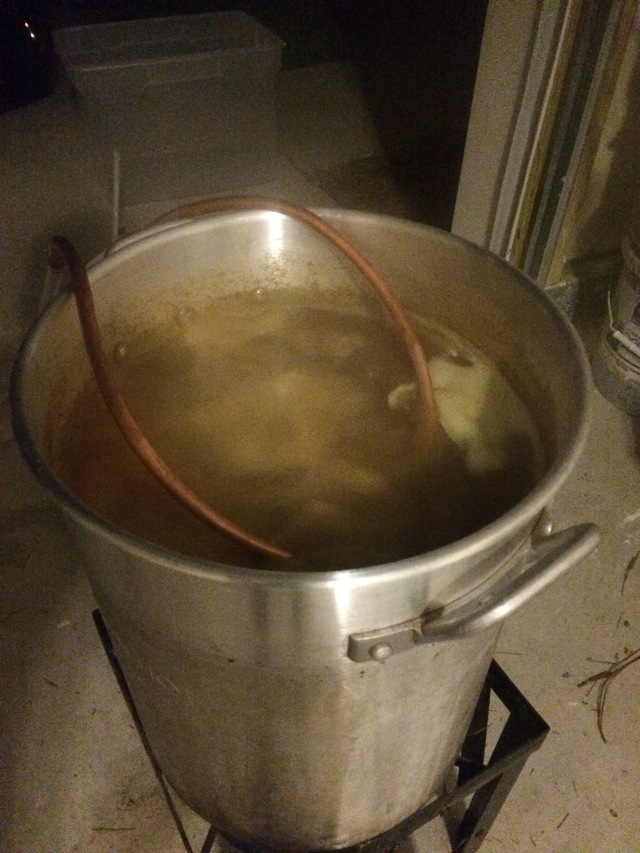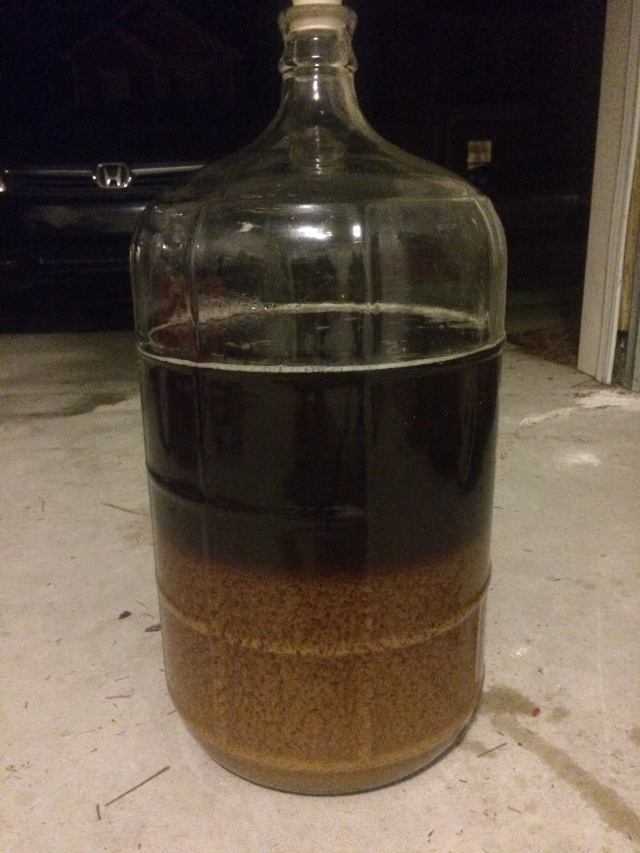This post is one in a series of making small adjustments to a single recipe in order to improve it, learn more about the impact each ingredient has on the finished product, and the art of recipe creation. The rest of the series can be found here.
Brew Day
My first brew night. I’m usually a Saturday morning/afternoon brewer, but I decided to take advantage of a Friday evening my wife would be spending with her friends. The night before, I cleared a space in the garage, cleaned all my equipment, prepared a batch of Starsan in my carboy, gathered water and treated it for chlorine, and even measured out my strike water into my HLT so that all I had to do when I got home after work was turn my burner on.
Brewing on a Friday evening makes for a long day of anticipation at work, but everything being ready to go when I got home helped things run smoothly—mostly. The only hiccup I had was my burner turning off while I was inside waiting for my mash water to come up to strike temperature. When I went back outside with the expectation of doughing in, I briefly worried that I had run out of propane. It turned out that the button on this turkey fryer’s “safety timer” (which I had bypassed to avoid my flame going out every 15 minutes if I forgot to reset the timer) simply wasn’t depressed. That was only about a twenty minute setback for the night.
After waiting yet again for my strike water to come up to temp, I doughed in and reached my target temperature. Then, taking advantage to one of the longer wait times on brew day, I made my daughter dinner. After eating, the 1.25 hour mash was just about finished, so I drained my mash tun, ran two batch sparges, and got the little one to bed. With the baby monitor out in the garage with me, the rest of the night went smoothly.

After cooling my wort down with my immersion chiller, I began to clean, giving my wort some time to settle after stirring it during the chilling process. Even then, I still got a fair amount of hop particulates in my carboy, making for some crazy stratification in the time it took me to clean my kettle.

On another note, after taking meticulous notes on the volumes collected from my sparges, the amount collected after boil, and truly calculating my boil-off rate for the first time, I came to a realization. I’ve questioned before why my efficiency has been so seemingly variable. I also thought that I figured out the cause (or at least a contributing factor) after last brew day. Being fully confident of my numbers this time, and all other things being equal, I’m going to point fingers elsewhere and say, “It’s not my fault!” like a child. But seriously, after using more grain than before, taking the gravity of all my runnings, measuring my boil-off rate, and gathering less post-boil wort than I did in Iteration 2 when my OG was 1.064, the only factor that hasn’t been addressed is my crush. Since I don’t own a mill, I rely on my LHBS to crush my grain for me. So, while I feel a little vindicated, I feel simultaneously defeated since I’m currently at the mercy of another to dictate my OG (since it’s been so variable recently, I can’t predict with accuracy how to adjust my grain bill for it). I’m not sure how I’m going to address this just yet. Of course the simple solution is also the expensive solution: buy a mill. We’ll see.
Recipe
Iteration 4 left me with a similar problem to Iteration 3 of this red IPA: the malt I had chosen to bolster the dark fruit flavors I was getting from the C120 had instead overpowered those flavors and left me with what I would classify as a different style of beer altogether. Iteration 4 specifically had an intense breadiness from the Munich malt that was more than what I wanted in this brew and also overshadowed the hops; however, there was a richness and depth to the malt character that I wanted to keep. I also noted that the increase in C120 in this recipe produced roasted flavors that I had not perceived before. These were all things I wanted to change.
This left me with three questions from the last brew:
- How do I tone down the breadiness while maintaining the current malt complexity?
- How can I make the malt character richer without it clashing with the hops?
- How do I eliminate the roasted character of too much C120 while getting more dark fruit flavor than I got before?
I questioned at first whether I should cut down the amount of Munich used or if I should try a new malt altogether. This time, though, the answer to that question seemed simple for a few reasons. Of course, Munich is generally touted as a “more intense Vienna” or vice versa. This alone made the switch to Vienna an obvious choice. Why cut something that may still be too strong (or might not be the backbone this beer needed) in a lesser amount when I could use a different malt that is purported to have a similar but less intense character? The other reason this was a simple choice was that in all my other considerations for additional malts to use for this beer, Vienna was the only one that I hadn’t yet tried. It was my hope that this change would be my answer to the first two questions above.
The question of eliminating the roast character of the C120 also seemed simple, but getting more of the dark fruit flavor at the same time seemed less so. I could easily lower the amount of C120 to an amount I had used before, because the percentage of C120 in Iteration 4 was a little over 11%. In retrospect, I should have expected some sort of negative impact with that much dark crystal. In the end, I simply lowered the amount of C120 used and hoped that the less intense flavors of Vienna would allow the plum and cherry flavors to shine through.
One more change that I made this time was to up my grain bill as a whole in an attempt to bring the ABV of this beer up to a respectable IPA strength. Now that I know where the issue of my continually lowering OG is truly coming from, hopefully next time I can return this beer to a 7% ABV like I achieved in Iteration 2.
- Mashed at 150⁰ F for 1.25 hrs.
- 10 lbs. 2-Row
- 1 lb. Crystal 120
- 1 lb. Vienna
- Boiled for 1 hr.
- 0.5 oz. Simcoe (60 min) at 12.2% AA
- 0.5 oz. Simcoe (30 min) at 12.2% AA
- 0.5 oz. Cascade (15 min) at 5.0% AA
- 0.5 oz. Centennial (5 min) at 9.7% AA
- Pitched US-O5
- OG: 1.056
- FG: 1.008
- ABV: 6.3%
- Dry hopped 0.5 oz. Cascade and 0.5 oz. Centennial for 4 days.
- Bottled and primed with 4 oz. of priming sugar.
Tasting
I knew going into this brew that my color was going to be a bit lighter than I wanted it to be. At an estimated 14 SRM, I knew the color would be closer to Iteration 1 than the actual red color I achieved with some of the more recent versions. This didn’t really bother me since I wanted to see how these flavors would play together first before adjusting the color (which is much less important to me).

The aroma of this beer had more hop character to it than I’ve achieved before. I’m hoping that this is the result of some adjustments I’ve made after discovering that I had an issue with oxidation, and I would venture to say that it likely is since I haven’t changed anything about my hops yet in this process. The citrus and floral hop aroma came through nicely. There was also a nice mix of malt character in the nose, with notes of toast and plum.
The flavor of this beer immediately hit me with plum, and citrus. There was a good depth of malt richness without being too rich for the style and without overpowering the other flavors. This time, the richness served as a backbone to everything else, which was the hope all along. The finish was one of cherry and citrus, which was absolutely delicious.
Goals for the Next Brew
I think I’ve got my malt bill. I might add an ounce or two more of C120 just to adjust the color, but the malt character this combination yielded was what I’ve been after. It’s a simple malt bill, but it works well.
The focus from this point will be on hops. Somehow the variables here seem more daunting to me than the malt, though. Balancing type and amount of malt is one thing, but I think it’s the added element of boil time and the subsequent bitterness/aroma balance that makes this next part seem like it’s going to take more trial and error than getting the malt bill right.
The bitterness of this Iteration was a little harsher than I’d like, but it had a good level of bitterness. Overall, I’d also like to see more aroma and flavor. The citrus and floral character that this current combination of hops, amounts, and boil/dry hop schedule gives me has been nice, but I’d like to see a little more citrus and a little less floral notes.
The questions I’m left with as I go forward are these:
- How do I lessen the harshness of the bitterness without lowering the level of bitterness?
- How do I achieve more citrus flavor/aroma and less floral (while still maintaining some of that)?
- How should I adjust my boil/dry hop schedule to achieve more hop aroma/flavor?
- Should I change my hop combination?
- Should I add more hops (in weight)?

Really enjoying these iterations – great to see all the work being put in to getting one recipe perfect!
It might be worth looking at lowering your start of boil hops and then adding a huge charge at 0 mins and allowing this to stand for 20 minutes as the wort cools. If you add the hops whilst the wort is still hot enough you still get an IBU contribution (I calculate it at around 3% utilisation) so you can caluculate your bitterness that way – it makes a much smoother bitterness in my experience and because the boil has ended you aren’t driving off as much of the hop aromatics and flavour so you’re getting a big hop contribution that way too.
If it was me (and this is just personal preference) I wouldn’t bother with 30, 15 and 5 – I’d just go for 60 and 0 and get most of your bitterness from the 0. Scott Janish wrote about how dry hopping can contribute to bitterness too (not in actual IBU’s but humulinones and and none isomerised alpha acids) so big dry hopping can increase the perceived bitterness. [source: http://scottjanish.com/zero-hot-side-hopped-neipa-hplc-testing-sensory-bitterness/%5D
Also, citronellol is thought to be one of the hop compounds that contributes to citrus character and geraniol is converted to beta-citronellol via biotransformation so if you find hops that are high in geraniol (like Chinook, Citra, Mosaic, Motueka) and use them for dry hopping during fermentation they should potentially create the citrus hop character that you’re after.
I’m really interested to see the hop experiments! Good luck getting this beer exactly how you want it!